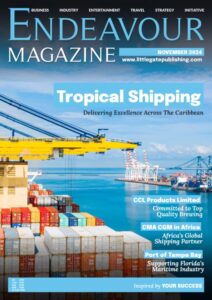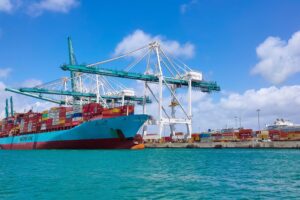As the 4th largest port in California, the Port of San Diego is a leading hub of maritime operations along the U.S. West Coast with a wealth of cargo and cruise operations under its portfolio, as well as shipbuilding and repair, and commercial and sportfishing operations across the maritime sector. We are thrilled to be catching up with the Port of San Diego once again, hearing from Michael LaFleur, Chief Operations Officer and Joel Valenzuela, Vice President, Maritime & Operations, in addition to Principal of Maritime Business Development, Greg Borossay, at the Port of San Diego. We are excited to bring you first-hand updates from across the Port’s expansive maritime portfolio, to hear how it has continued to develop its business lines over the last year, the Port’s plans for 2026, and how it remains committed to supporting a sustainable maritime sector.
Check out the article in the magazine below:
The Port of San Diego benefits from a natural deep-water harbour and two cargo terminals, which provide easy access to regional freeways and an on-dock Class I rail service. This infrastructure has long made the Port ideal for cargo shipping, offering the space, expertise and flexibility to move cargo – particularly cargo that does not fit into standardised containers. As a result, the Port now plays a vital role in shipping specialised cargo, including breakbulk, roll-on/roll-off, dry bulk and refrigerated cargo.
With its growing cargo business supported by its infrastructure and location, the Port of San Diego is known as the speciality cargo gateway to the Pacific for the U.S., with a wealth of cargo travelling along regular trade routes across the globe.
The central cargo trade regions for the Port are Europe, Asia and Latin America. For Europe, the Port handles inbound cargo including automobiles, steel products, yachts, fertiliser, machinery and components for wind and energy development. The primary cargo inbound from Asia includes automobiles, machinery, project cargo, energy components, transformers and generators, steel products, ship engines, paper rolls and bauxite. Then, for Latin America, the Port’s import cargo includes bananas and other fresh fruit, perishables, seafood, and bulk sugar. The Port is also responsible for exporting beef, retail goods and other light manufacturing goods to Latin America.
Of note, the Port currently has breakbulk contracts with G2, US Ocean and Norden (formerly Thorco) as well as a weekly container service with Dole Fresh Fruit at the Port’s Tenth Avenue Marine Terminal. The Port also has relationships with Eastern car carriers, Eukor, Glovis and NYK together with Pasha Automotive at its National City Marine Terminal.
When we last spoke with the Port of San Diego, we learned about the increase in the Port’s cargo lifting capacity thanks to the introduction of electric cranes in 2024. Speaking once again to Greg Borossay, Principal of Maritime Business Development at the Port of San Diego, he outlined that in 2025, the cranes have continued to deliver significant cargo operations for the Port. Borossay shares that in the first year alone, the cranes have been invaluable in growing the Port’s cargo business, including helping to offload specialised cargo, supporting rail to ship transfers and aiding in the movement of project cargo. Thus, Port of San Diego is now primed with the facilities and equipment to handle cargo that was previously only handled by ports along the Gulf Coast, highlighting it as a vital hub for trade for the U.S.
Reflecting on the expansive growth of the Port in recent years, we asked Greg Borossay about the Port’s goals towards expanding its trade links across the world over the coming years. Borossay outlines that, “The Port of San Diego is looking to increase our container business in the coming years across more international markets. Now that we can handle up to 400MT lifting capacity with our new electric mobile harbour cranes, we are working to recruit a monthly or twice-monthly container service to focus on Japan and Southeast Asia.” The Port presently has sister port relationships with Ensenada Mexico, Nanjing China, and Sasebo Japan with an intent to expand these relationships to include Korea and Vietnam. With the expansion of the Port’s relationships across more markets around the globe, the Port looks set to grow its container business, further solidifying the Port of San Diego as a hub primed for international cargo operations.
When we last spoke to the Port of San Diego, we also heard about how one of the Port’s goals for 2025 was to expand its cruise line operations. Therefore, we were excited to speak to Joel Valenzuela, Vice President, Maritime & Operations for the Port of San Diego, about the developments of the Port’s cruise line operations. Valenzuela outlines that the Port has seen an upward trajectory in its cruise calls, and in turn, the number of passengers travelling through San Diego. However, the upcoming season looks set to be even more pivotal for the Port, as Valenzuela highlights that, “Next season (2026-2027), we are expecting to reach 190 calls and 800,000 passengers. It will be our biggest year since the 2007-2008 season, and it’s thanks to the addition of Norwegian Cruise Line’s homeports starting this season, as well as next season’s new Royal Caribbean homeports plus Disney Cruise Line’s expanded service.” As the Port’s cruise services continue to expand over the coming season, Valenzuela highlights the great partnership the Port has with cruise lines and says that the Port “will be looking to continue growing with them as well as partners for needed development of our facilities to support future cruise growth.”
In Valenzuela’s comments on the expansion of the Port’s cruise services, he highlighted that Norwegian Cruise Line has added San Diego as a homeport for the first time. This addition will be vital for the Port of San Diego, with Norwegian Cruise Line expected to make 21 calls this season. In addition, Royal Caribbean will also utilise San Diego as a homeport for the 2026-2027 cruise season, expecting to make 45 calls during this period. This means that in total, the Port of San Diego is a homeport across four major cruise lines, with Norwegian Cruise Line and Royal Caribbean joining Holland America Line and Disney Cruise Line. Disney Cruise Line also recently announced that it would be expanding its service, which will see it bring two ships to San Diego during the 2026-2027 cruise season, making an anticipated 60 calls and attracting an estimated 285,000 total passengers.
The expansion of the Port of San Diego’s cruise line business is significant because when operating as a homeport along cruise itineraries, the cruise industry brings approximately $2 million in regional economic impact, and $600,000 when a visitation port. This means that on average, San Diego’s cruise season generates anywhere between $125 and $250 million each season. In fact, according to the Port’s most recent economic impact report, in the fiscal year 2023 (FY 2023), the Port of San Diego’s cruise industry injected $184 million into San Diego County’s economy. This massive economic impact of the cruise industry highlights just how vital the expansion of the Port’s cruise line operations is for supporting the local economy in San Diego.
Across all of the Port of San Diego’s operations, sustainability remains a firm priority. A recent significant development in the Port’s sustainability initiatives is the active leadership role it has taken in its Blue Economy Incubator, as outlined by Michael LaFleur when we spoke. LaFleur, Chief Operations Officer at the Port of San Diego, outlines that, “As part of our commitment to promote the development of a sustainable ocean economy, we established the Blue Economy Incubator in 2016. It serves as a launch pad for Port-related sustainable aquaculture and blue technology ventures.” LaFleur continued, “Through the Blue Economy Incubator, the Port is building a portfolio of new businesses and partnerships that deliver multiple social, environmental, and economic co-benefits to the Port and the region. To date, the Port has provided $2.35 million in funding to support the launch of 11 innovative pilot projects.” As we can see from LaFleur’s comments, sustainable business development remains at the heart of the Port, with its development of projects across the aquaculture, coastal resilience and maritime decarbonisation sectors designed to help reduce the environmental impact of maritime operations across San Diego.
In 2021, the Port of San Diego adopted the Maritime Clean Air Strategy (MCAS), which was designed to improve environmental and public health through cleaner air for all who live and work around San Diego Bay. LaFleur highlighted that the Port has been implementing and making significant progress across 80% of the objectives that were outlined by MCAS, delivering a notable decrease in emissions related to maritime operations. LaFleur told us that, “In recent years, the Port and our partners have committed more than $227 million toward projects including electrical infrastructure, electric cargo handling equipment and technology deployments, berth rehabilitation, and at-berth emissions reduction equipment.” This vital investment towards sustainable development across the Port’s infrastructure highlights its future-focused outlook to deliver a cleaner and more sustainable maritime sector now and for the future.
A significant site of current development of the Port is at the National City Marine Terminal, where the Port is focused on berth repairs. LaFleur outlines that the Port is working with the Oregon Shipping Group, the Port of Bellingham, MARAD and Caltrans to open a new coastal shipping corridor: the West Corridor M-5 Coastal Connector. This will allow barge transportation for building materials, containers, and general cargo for both north and south routes. The goal of this is to provide supply chain resiliency and reduce truck trips by introducing a coastal connector. The development of the West Coast M-5 Coastal Connector is one of the major developments being carried out at the Port of San Diego as we enter 2026, in the hopes that it will provide flexibility and cost savings for domestic cargo customers and help to get more heavy-duty trucks off the road to reduce air emissions and traffic along the Interstate 5 corridor in the process.
In addition, the Tenth Avenue Marine Terminal is also being developed towards several zero-emission initiatives. These include the upgrading of the existing electrical system to support the installation of additional shore power systems and more battery electric cargo handling equipment. The current plan is in its second phase of development, with on-terminal rail track replacement, realignment and local capacity improvements being carried out. The plan will also see seismic upgrades, concrete resurfacing, the potential for additional stormwater improvements, water and utility reconfiguration and upgrade, as well as a front gate, perimeter fence and an operations centre developed. LaFleur highlights that, “These improvements will maximise operation areas on the terminal, make cargo handling and movement more efficient, and support future charging technology for electric vehicles and equipment.” This development project is vital for the Port of San Diego as it supports its speciality cargo advantage by providing laydown space and flexibility for project, roll-on/roll-off, and breakbulk cargo.
As the Port of San Diego looks toward the future, infrastructural development, strengthening of the Port’s cargo services and delivering additional trade routes across the globe are the central priorities of the Port. Greg Borossay outlines that the Port’s strength remains in speciality cargo, and so it will continue to prioritise and develop opportunities in the bulk and breakbulk sectors. Alongside the opening on the M-5 Coastal Connector, Borossay says the Port wants to, “further develop our bulk sector to make the Port of San Diego a premier clean bulk gateway for medium-sized export and import bulk like sugar, bauxite, sand and soda ash – something the other Southern California ports don’t have the space or operational capacity to accommodate.” Then, for global trade development, the Port hopes to continue outreach to European carriers regarding niche service potential to Asia and Europe, and extend its trade connection across the globe. With these vital developments established to lead the Port into the coming year, the Port of San Diego continues to grow as an expansive, competitive and sustainability-focused port delivering significant economic developments for San Diego and beyond.
From all of our conversations with the Port of San Diego, development towards the future remains a key priority. With its cargo and trade business positioning the Port as a hub for cargo trade along the West Coast of the U.S., the Port is continuing to diversify its cargo operations and connect the port with more markets across the world. Alongside this, the Port is establishing a lucrative cruise line business through its partnerships with key cruise liner operators across the world. To facilitate all of this, the Port continues to expand its infrastructure, whilst remaining sustainable, and serving as a thriving hub of economic development for the San Diego region. We look forward to catching up with the Port of San Diego again soon to see how its cargo, trade and cruise line operations continue to grow over the coming years.









Add Comment